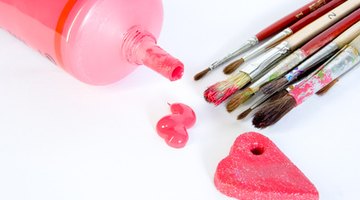How to Make Pink Camouflage
Pink camouflage is not functional, but it is a popular fashion and design motif. Pink camouflage designs and styles commonly seen in clothing, decorating and craft projects are meant to enhance an item or wall.

Things You Will Need
- Item to paint
- Bright or dark pink paint
- Light pink paint
- White paint
- Gray paint (optional)
- Black paint (optional)
- Paintbrushes
- Clean rags or paper towels
- Paint remover (optional)
Making your own pink camouflage design is not hard to do if you are willing to put some thought and practice into it. It is an enjoyable task that is easy to learn and which you can then use for many craft projects.
-
Pick the item carefully that you want to paint in pink camouflage. If choosing a T-shirt, painting a letter or a small area is less likely to stiffen the shirt, making it more comfortable to wear as opposed to painting the entire surface. If painting a room, one wall instead of all four is often better for an accent wall with such a bold pattern. Small wooden boxes, pillows, school book covers and picture frames are other options you can apply a pink camouflage motif to. Use paint products designed for the item you choose to paint.
-
Buy three colors of paint: dark or bright pink, light pink, and white. Some pink camouflage designs have black or gray shapes; buy these shades if you'd like to include them in your project. The choice of pink colors should be complementary and at least two shades away from each other to provide contrast.
-
Apply the lightest color first – white. Make random, but evenly spaced, freeform shapes across one-third of the area, or one-fourth of the area if you are also using black. Wavy, irregular shapes with an elongated shape work better than circular or square designs. You could also opt to start with an all white background, which would leave no spaces with unintended colors. Allow the color to dry to avoid smearing or mixing the colors.
-
Repeat with the lighter shade of pink. Place the freeform designs in random areas, some next to the white and touching different sides of the white. Allow this color to dry before applying the brighter pink color.
-
Make gray freeform designs next, if you opted to use gray. This color helps mute the boldness of pink camouflage, toning down the overall design. Smaller freeform shapes than used for the pink keeps the focus on pink. Allow all colors to dry in between each step to avoid smearing and mixing the colors.
-
Apply the darker or brighter pink in the same style as the previous colors, overlapping some colors and making larger designs. This pink is the main color and using it to make slightly larger freeform designs helps emphasize the main pink color. If you are only using three colors, be sure all the blank areas on the surface are covered.
-
Use small, black freeform designs sparingly. Black is bold and may be overpowering for the project. Black adds a good contrast when used as a highlight color rather than a main color. Practice on a sheet of paper first of you are unsure of how much is too much. Allow to dry thoroughly before applying a sealant or overcoat of any kind.



Tip
View examples of camouflage to get ideas of freeform shapes. Using darker colors first makes it harder to fully cover them with lighter colors if needed. Use paper towels, rags, or paint remover to eliminate any design mistakes you may have made while painting.
Warning
Follow all manufacturers’ directions for the choice of medium, whether paint, marker or fabric paint.
References
Tips
- View examples of camouflage to get ideas of freeform shapes.
- Using darker colors first makes it harder to fully cover them with lighter colors if needed.
- Use paper towels, rags, or paint remover to eliminate any design mistakes you may have made while painting.
Warnings
- Follow all manufacturers' directions for the choice of medium, whether paint, marker or fabric paint.
Writer Bio
With over 30 years of experience with animals and 20 years with gardening, Amy Reynolds has been writing professionally and publishing online since 2005. She is currently considering pursuing a degree in Web design for a new venture.
Photo Credits
- John Rensten/Photodisc/Getty Images
- John Rensten/Photodisc/Getty Images
- paint brushes image by Horticulture from Fotolia.com
- brush in paint image by Vladislav Gajic from Fotolia.com
- paint brush image by anna karwowska from Fotolia.com
More Articles



